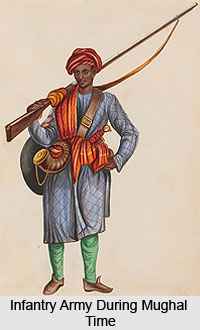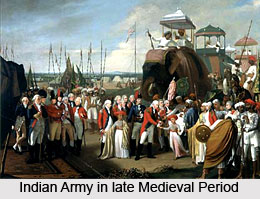 Indian army during the medieval period was quite different from the structured form of the contemporary army. The Indian Army has seen a lot of changes in its formation, structure, war policy etc. from the ancient period to medieval period to the modern period. Mainly the war policies of the kings and the rulers outlined the structure of the then Indian army. In the medieval period, the Indian emperors and kings were famed in applying a number of tactics and diplomatic policies for winning a war and also sometimes for avoiding an open war. To understand the structure of the medieval Indian army it is indeed necessary to have a brief idea about the thought process of the Indian kings in the ancient and medieval period. Kautilya`s Arthasastra offers a vivid description about the formation and condition of Indian Army during that period whilst unfolding the thought process of the rulers. Kautilya has actually made a primary distinction in military affairs between secret, or covert, war and open warfare which was certainly prevalent in medieval India.
Indian army during the medieval period was quite different from the structured form of the contemporary army. The Indian Army has seen a lot of changes in its formation, structure, war policy etc. from the ancient period to medieval period to the modern period. Mainly the war policies of the kings and the rulers outlined the structure of the then Indian army. In the medieval period, the Indian emperors and kings were famed in applying a number of tactics and diplomatic policies for winning a war and also sometimes for avoiding an open war. To understand the structure of the medieval Indian army it is indeed necessary to have a brief idea about the thought process of the Indian kings in the ancient and medieval period. Kautilya`s Arthasastra offers a vivid description about the formation and condition of Indian Army during that period whilst unfolding the thought process of the rulers. Kautilya has actually made a primary distinction in military affairs between secret, or covert, war and open warfare which was certainly prevalent in medieval India.
The first Turkish conqueror was Mahmud of Ghazni (997-1030) who led as many as seventeenth invasions of India. It was he who took his forces across the Indus River and eventually his sway extended to the Ganges. The second Turkish invader was Shahabuddin Ghori. In 1190, having advanced to Tarain near Delhi, his outnumbered Army was defeated by Prithviraj Chauhan. As invaders of the earlier waves settled and became Indians, they in turn were flooded by other succeeding waves. This sequence of consecutive invasions and conquests went on continuous for around eight centuries. The invading Turks were found to have had tremendous energy, briskness and resilience. They also had faster mobility, being mounted on fast, tough Turkoman and Arabian horses. Their armies were in fact hosts of mounted archers functioning in the old and effective traditions of Parthians, Huns and Mongols. Their composite bow was as good a weapon as any of the defenders, but being good riders they used it to better effect. The long period of anarchy following the invasion and plunder of northern India by Timur in 1392 AD attracted the attention of Babur, who descendent upon India with his Mughal Army in 1525. Next year he defeated the Sultan of Delhi, Ibrahim Lodi at Panipat. He used cannons for the first in India.
According to Kautilya, Indian army during medieval period fought mainly the open warfare which was simply the conventional. Indian Army during medieval period was also trained in the secret warfare technique, which included identifying the treasonous elements in the forces of the enemy and attacking the portions of the enemy line. It also included instigating rebellion among enemy troops, especially by means of psychological warfare and methods of instilling terror in the enemy by means of ruses, assassins, occult practices, or elephants. In the medieval period, the spies probably played the most important role in a war, be it open or the secret one. In the ancient and medieval period, most of the members of the Indian Army were from the two upper castes of the society, the Kshatriyas and Brahmins. The Kshatriyas were considered to be the warrior caste and they had to fight well on the battlefield to satisfy the obligations of their caste.
According to the epic, Mahabharata, what is unrighteous in the case of others is unavoidable in the case of Kshatriyas and the Kshatriya should act in such a way that he may not suffer in his religious merit (dharma), but he should by all means rescue his own self. Apart from the above mentioned written scriptures, the ancient oral tradition of the Puranas, folktales of India also deal with the Indian Army and its war policies. The military contents of the Indian Puranas are estimated to date from 600-800 AD.
 Three of the 36 Puranas that are enumerated by the scholars, like the Agni Purana, Matsya Purana and Visnudharmottara Puranas, are particularly concerned with war. These Puranas describe two types of wars, named the Prakasa, or declared war, and Aprakasa, undeclared war. Both the forms are similar to that of Dharma Yuddha and Kata Yuddha, which were discussed by Kautilya and Mahabharata. The Puranas also identified the Sama Niti and Dana Niti as ways of winning against an enemy without fighting.
Three of the 36 Puranas that are enumerated by the scholars, like the Agni Purana, Matsya Purana and Visnudharmottara Puranas, are particularly concerned with war. These Puranas describe two types of wars, named the Prakasa, or declared war, and Aprakasa, undeclared war. Both the forms are similar to that of Dharma Yuddha and Kata Yuddha, which were discussed by Kautilya and Mahabharata. The Puranas also identified the Sama Niti and Dana Niti as ways of winning against an enemy without fighting.
The emergence of the Jainist philosophers and the Jainist movement during the seventh century AD influenced the activities, formation and war policy of the medieval period`s Indian Army and war policies quite significantly, as the Jainists depreciated war as a tool of statecraft. They felt that as the war was quite uncertain in its outcome, it should be resorted to only when intrigue had been tried and had failed. Undoubtedly, the morale of the Indian Army was directly linked with the presence of the leader on the battlefield. The members of the Army were highly loyal to the king or commander and they were not likely to survive after the death or disappearance of the leader.
The existing caste system in the Indian society left a huge impact on the Indian Army in the medieval period. The caste structures were tended to divide society into subgroups that displayed internal loyalty but did not encourage significant loyalty across caste lines. However, though the impact was there, the caste system did not affect the capabilities of the Indian military. A large number of commanders and kings in the ancient and medieval India did fight the wars, alongside their infantry and soldiers to shoulder with the peasants. This helped to enhance the unity of the Indian Army during the medieval era which aided in showcasing the truth that the entire army will fight hard and not leave any of their companions to be isolated and destroyed.
Talking about the size of the Indian Armies in the ancient and medieval period, different mighty and powerful kings and emperors of India had different size of armies. According to the researchers and scholars, the combined armies of the eight major kingdoms in India during the invasion of Alexander the Great was 1,078,000 infantry and 216,000 cavalry. Apart from the collective strength of the major Indian kingdoms, the scholars say that the great imperial power, Chandragupta Maurya had Army strength of 600,000. There is another estimate of Chandragupta`s army available and this included all his military personnel. This number was estimated at a figure of 690,000. However, both the figures have eventually been derived from references to the reports of the Greek ambassador to India, Megasthenese. According to the memorial inscriptions, the great king Ashoka had fought battles in the area of the Bay of Bengal in which his army killed about 100,000, and captured 150,000 people. This information gives an idea about how large the Army of Ashoka was. According to some other historical evident, the Army of Chandragupta Maurya included large numbers of infantrymen, charioteers, and soldiers mounted on elephants. However, there were no stirrups or horse-mounted archers in Indian Army until the very end of the period 500-900 AD. The period also witnessed another change in the Indian Army and the change was that the people from the Vaishya Varna started to come to the Army, along with the Kshatriyas and Brahmins.
During that period, the Indian Armies were not seemed to have been standing armies and they were drawn as needed from the community as a whole. The members of the Indian Armies during the medieval period were also given individual training, as part of military training. In the eighth century AD, the Indian society was divided into two major classes, the warriors and non-warriors and the peasant militia fought alongside charioteers and elephant-mounted aristocrats, during that period. The Indian Army actually reflected the society from which they came from and they were also not professionalised enough. As a result, the coordination among the various components of the Indian army and the cohesion between Indian commanders and their troops was poor. In fact, there was clearly a lack of solidarity among the Indian tribes or cohesion between the soldiers and their officers and the Indian armies of that time were also significantly different in the level of military cohesion they displayed.






